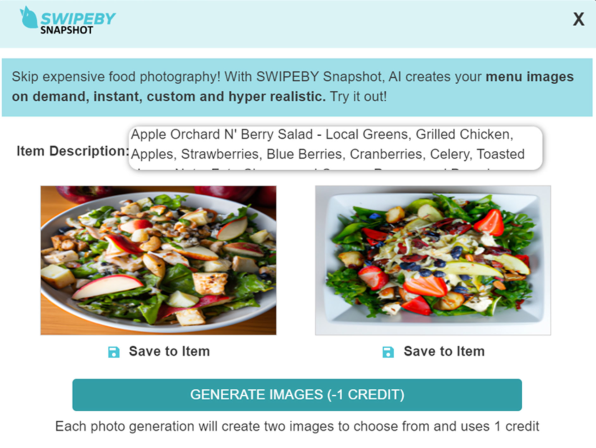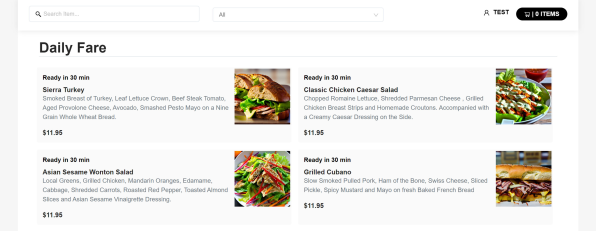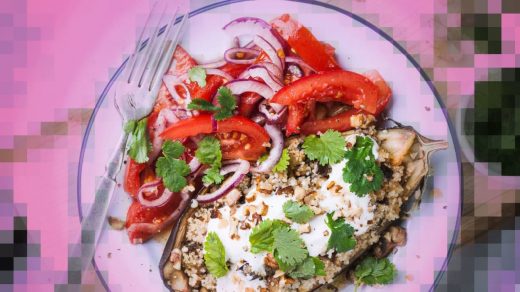The picture of that food you’re ordering online may have been created by AI
By Rafael Canton
Companies have been using AI to help with everything from graphic design to healthcare. Now we can add food photography to the list.
Swipeby, a Winston-Salem, North Carolina-based startup that provides online ordering tools for businesses like restaurants, recently launched an AI text-to-photo app for its customers. Named Snapshot, the tool uses Open AI and Stability AI text-to-photo technology to create images of menu items based on descriptions of the food. Using a list of ingredients and other info, the AI tool can generate custom images of meals, down to the color of the plate they’re served on.

The company points to a survey from Snappr, a photography and visual content platform, that found high-quality food photos can increase orders on restaurant delivery apps by 35%.
“All of us here can relate to the problem that if you are at McDonald’s and see the pictures, or if you are at a Chinese restaurant and have a big menu with pictures, you sometimes order more,” Swipeby founder Carl Turner tells Fast Company. “You actually are able to see what you want, and it’s an easier decision process.”
Turner, who was born in Berlin and moved to the U.S. to attend college, launched Swipeby in 2019 after coming up with the idea in his dorm room. The business took off in 2020 as the company’s turnkey platform provided online ordering, pickup, and delivery solutions to small and midsize restaurants—mainly in suburban locales—during the pandemic. It has since expanded to brick-and-mortar businesses such as convenience stores and hardware stores and has hundreds of business customers.
Swipeby noticed that 80% of its clients don’t have photos for the majority of menu items on their websites. The cost of food photography is too high for many small restaurants, Turner says.
“We see this in our own metrics and accounts,” he says. “If you have pictures . . . you drive more orders. Conversion goes up, ticket size goes up. Every metric you could think about will be positively influenced for an ecommerce transaction.”
Michael’s on Main Cafés, a chain with more than two dozen locations in Illinois, began working with Swipeby during the pandemic when it was in search of a platform to provide online and hands-free ordering to its customers.
Michael Delisi, director of operations of Noteable Events Productions, operator of Michael’s on Main Cafés, says the chain has explored taking photos in the past but the costs were too high and the turnaround time for enhanced digital photo graphics prohibitive. Michael’s on Main changes its menus often, making it hard to constantly update incoming menu items with new photos.
“There is an old proverb that says ‘People eat with their eyes,’ so the tool has allowed us to offer a graphical representation instead of just words on a screen,” Delisi says. “The images have come out enticing for customers and we are hoping they continue to make mouths water.”
So what if those images were generated by a computer?

Of course, the world of food styling already employs all sorts of trickery to make food look more appetizing, and the Big Mac you see in the McDonald’s commercial may bear little resemblance to the real thing you get from the drive-through. Still, how accurate are the food photos generated by AI? And if the real food looks vastly different, won’t customers complain?
Turner claims the images are surprisingly accurate, since the AI can account for all details including any additional ingredients or toppings (although he notes that the company lacks data on whether online orders have been boosted by the new AI images).
It’s worth noting that these types of images may not fly on other delivery platforms. For instance, while DoorDash’s policies don’t address AI-generated food images directly, it typically rejects unrealistic photos, such as stock images, that aren’t taken by the restaurant.
Turner believes that won’t last long. “Give it six months, that will change,” he says. “I will bet money on it. Because with AI generation right now, it makes so much sense.”
(5)



